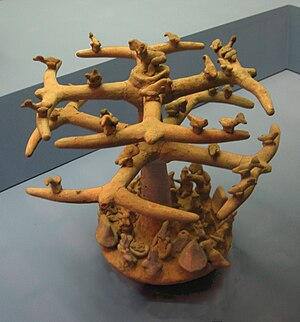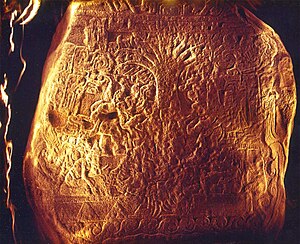Mesoamerican world tree


World trees are a prevalent motif occurring in the mythical cosmologies,
pre-Columbian cultures of Mesoamerica. In the Mesoamerican context, world trees embodied the four cardinal directions, which also serve to represent the fourfold nature of a central world tree, a symbolic axis mundi which connects the planes of the Underworld and the sky with that of the terrestrial realm.[3]
Depictions of world trees, both in their directional and central aspects, are found in the art and mythological traditions of cultures such as the
Mayan language.[4] The trunk of the tree could also be represented by an upright caiman, whose skin evokes the tree's spiny trunk.[5]
Directional world trees are also associated with the four Yearbearers in
Mesoamerican codices which have this association outlined include the Dresden, Borgia and Fejérváry-Mayer codices.[6] It is supposed that Mesoamerican sites and ceremonial centers frequently had actual trees planted at each of the four cardinal directions, representing the quadripartite concept.[citation needed
]
Izapa Stela 5 is considered a possible representation of a World Tree, as is the tree on Kʼinich Janaabʼ Pakal's sarcophagus at Palenque.[7]
World trees are frequently depicted with birds in their branches, and their roots extending into earth or water (sometimes atop a "water-monster", symbolic of the underworld).
The central world tree has also been interpreted as a representation of the band of the Milky Way.[8]
See also
- Axis mundi
- Aztec mythology
- Maya mythology
- Olmec mythology
- Tree of life
- Vision Serpent
- Yggdrasil
Notes
- ^ AMNH, "Mexican and Central American Hall, AMNH". Archived from the original on 2008-09-28. Retrieved 2008-04-23., which further cites Butterwick, Kristi (2004) Heritage of Power: Ancient Sculpture from West Mexico, Metropolitan Museum of Art.
- ^ Kappelman
- ^ Miller and Taube (1993), p.186.
- ^ Finlay (2003)
- ^ Miller and Taube, loc. cit.
- ^ Ibid.
- ISBN 0684852098.
- ^ Freidel, et al. (1993)
References
- Adkinson, Robert, ed. (1996). The Maya: Sacred Symbols (Sacred Symbols Series). London: Thames and Hudson. ISBN 0-500-06022-3.
- Finley, Michael (2003). "Raising the sky: The Maya creation myth and the Milky Way". The Real Maya Prophecies: Astronomy in the Inscriptions and Codices. Maya Astronomy. Archived from the original on 2006-12-25. Retrieved 2007-01-04.
- Freidel, David A.; ISBN 0-688-10081-3.
- Kappelman, Julia "Art 347L Mesoamerican Art Syllabus: West Mexico", accessed April 2008.
- McDonald, J. Andrew. “DECIPHERING THE SYMBOLS AND SYMBOLIC MEANING OF THE MAYA WORLD TREE”. In: Ancient Mesoamerica 27, no. 2 (2016): 333–59. doi:10.1017/S0956536116000249.
- ISBN 0-500-05068-6.
